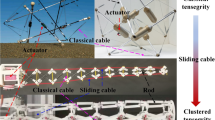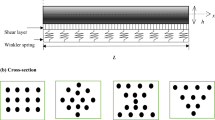Abstract
A numerical solution based on the Steffensen stable point iterative method is proposed to resolve the transcendental frequency equation of a stay cable-damper system. The frequency equation, which considers clamped supports and flexural rigidity of the cable, is intended to investigate the influence of the parameters of the cable damper system on its dynamic characteristics. Two factors involved in the design and construction phases, the damping coefficient induced by external dampers and the cable tension, are the focus of this study. Their impact on modal frequencies and damping ratios in these two phases of cable-damper systems are investigated by resolving the equation with the proposed solution. It is shown that the damping coefficient and cable tension exert more noticeable effects on the modal damping ratios than on the modal frequencies of stay cable-damper systems, and the two factors can serve as design variables in the design phase and as adjustment factors in the construction phase. On the basis of the results, a roadmap for system-level optimal design of stay cable-damper systems that can achieve global optimal vibration suppression for the entire bridge is proposed and discussed.
Similar content being viewed by others
References
Boston C, Weber F and Guzzella L (2011), “Optimal Semi-active Damping of Cables with Bending Stiffness,” Smart Materials and Structures, 20(5): 8–15.
Fujino Y and Hoang N (2008), “Design Formulas for Damping of a Stay Cable with a Damper,” Journal of Structural Engineering, ASCE, 134(2): 269–278.
Huang ZH and Jones NP (2011), “Damping of Taut-Cable Systems: Effects of Linear Elastic Spring Support,” Journal of Engineering Mechanics, ASCE, 137(7): 512–518.
Irvine HM (1981), Cable Structures, The MIT Press, Cambridge, Massachusetts, USA.
Krenk S (2000), “Vibrations of a Taut Cable with an External Damper,” Journal of Applied Mechanics, 67(4): 772–776.
Krenk S (2004), “Complex Modes and Frequencies in Damped Structural Vibrations,” Journal of Sound and Vibration, 270(4–5): 981–996.
Krenk S and Nielsen SRK (2002), “Vibrations of a Shallow Cable with a Viscous Damper,” Proceedings of Royal Society A: Mathematical, Physical and Engineering Sciences, London, 458(2018): 339–357.
Main JA (2002), “Modeling the Vibrations of a Stay Cable with Attached Damper,” PhD Dissertation, The Johns Hopkins University, pp.31–32.
Main JA and Jones NP (2002a), “Free Vibrations of a Taut Cable with Attached Damper. I: Linear Viscous Damper,” Journal of Engineering Mechanics, ASCE, 128(10): 1062–1071.
Main JA and Jones NP (2002b), “Free Vibrations of a Taut Cable with Attached Damper. II: Nonlinear Damper,” Journal of Engineering Mechanics, ASCE, 128(10): 1072–1081.
Main JA and Jones NP (2007a), “Vibration of Tensioned Beams with Intermediate Damper. I: Formulation, Influence of Damper Location,” Journal of Engineering Mechanics, ASCE, 133(4): 369–378.
Main JA and Jones NP (2007b), “Vibration of Tensioned Beams with Intermediate Damper. II: Damper near a Support,” Journal of Engineering Mechanics, ASCE, 133(4): 379–388.
Pacheco BM, Fujino Y and Sulekh A (1993), “Estimation Curve for Modal Damping in Stay Cables with Viscous Damper,” Journal of Structural Engineering, 119(6): 1961–1979.
Weber F and Boston C (2011), “Clipped Viscous Damping with Negative Stiffness for Semi-active Cable Damping,” Smart Materials and Structures, 20(4): 13–19.
Weber F, Boston C, Feltrin G and Motavalli M (2009a), “Cable Damping with Friction and Combined Viscous-Friction Dampers,” IV ECCOMAS, Thematic Conference on Smart Structures and Materials, on CD, pp.345–352.
Weber F, Dist H, Feltrin G and Motavalli M (2009b), “Cycle Energy Control of MR Dampers on Cables,” Smart Materials and Structures, 18(1): 16–21.
Weber F, Distl H, Huber P, Nützel O and Motavalli M (2007), “Design, Implementation and Field Test of the Adaptive Damping System of the Franjo Tudjman Bridge nearby Dubrovnik, Croatia,” Proceedings of the IABSE Conference 2007, Weimar, on CD, pp.39–46.
Weber F, Feltrin G, Maślanka M, Foboc W and Distl H (2009c), “Design of Viscous Dampers Targeting Multiple Cable Modes,” Engineering Structures, 31(11): 2797–2800.
Author information
Authors and Affiliations
Corresponding author
Additional information
Supported by: Key State Laboratories Freedom Research Project under Grant No. SLDRCE09-D-01; the Fundamental Research Funds for the Central Universities, the Project of National Key Technology R&D Program in the 12th Five Year Plan of China under Grant No. 2012BAJ11B01; National Natural Science Foundation of China under Grant No. 50978196; State Meteorological Administration Special Funds of Meteorological Industry Research under Grant No. 201306102; and the Ministry of Education of China under Grant No. 2008B090500222
Rights and permissions
About this article
Cite this article
Dan, D., Chen, Y. & Xiao, R. Dynamic properties analysis of a stay cable-damper system in consideration of design and construction factors. Earthq. Eng. Eng. Vib. 13, 317–326 (2014). https://doi.org/10.1007/s11803-014-0233-1
Received:
Accepted:
Published:
Issue Date:
DOI: https://doi.org/10.1007/s11803-014-0233-1




